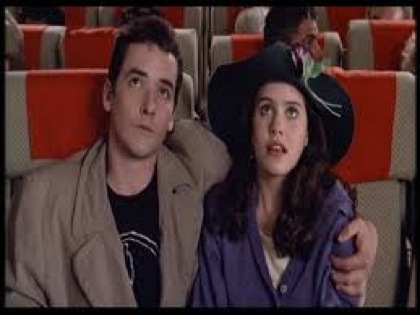I saw Cameron Crowe’s Say Anything again for the first time in years — and it’s still really good! Easily the best movie of Crowe’s I’ve seen…which maybe isn’t saying all that much, but still.
A big part of the film’s appeal is that both of its protagonists — John Cusack as Lloyd Dobbler and Ione Skye as Diane Cort — are likable and charming. This may seem like faint praise, but it seems to be an immensely difficult thing for modern romantic comedies to pull off. Maybe it’s because writers feel they need conflict and can’t figure out how to get it if somebody isn’t despicable; maybe it’s a misplaced effort at realism. Whatever the reason though, there are just an awful lot of romantic comedies where the guy is broken and repulsive and we’re supposed to cheer as the manic pixie dream girl saves him (as in Eternal Sunshine of the Spotless Mind) or in which all the characters are fairly repulsive (Pretty Woman), or in which the guy sleeps with someone else and you’re/she’s supposed to forgive him…or what have you. You’d think the baseline for a successful romantic comedy would be a couple who, when they get together at the end, it’s actually a happy ending. And yet, for the most part, when I see romantic comedies, I either can’t actually believe the protagonists will be happy, or wish they weren’t because I hate them.
But, like I said, that’s not a problem in Say Anything. Diane Cort, high school valedictorian, Rhodes scholar (or the equivalent), and Daddy’s girl, is super smart and shockingly good looking (the “body of a game show hostess” as one of Lloyd’s friends puts it), but she’s also sweet and shy and awkward, and (in part because she’s taken so many college classes off campus) disconnected from her classmates. Lloyd is goofy and unambitious — but he’s also caring and gentlemanly and (as his numerous female friends demonstrate) ready, willing, and able to treat woman with respect. There’s a lovely scene, in fact, where several of those female friends are sitting around, and one asks, skeptically, “Come on, if you were Diane Cort, would you fall for Lloyd?” And they all think about it for a minute, and decide that, in fact if they were her they would — because Lloyd’s great, and why wouldn’t she?
The low key rightness of the romance is perhaps what I like most about the film. Neither Lloyd nor Diane is broken; neither is miles out of the others’ league. Their romance is made up mostly of small moments; Lloyd kicking glass out of the way so Diane doesn’t step on it, or the two of them giggling as they scramble over each other to switch drivers in Diane’s car…or Diane pulling a blanket over Lloyd on the first night they have sex together because he’s cold. Instead of love as salvation, the movie presents love as a series of small intimacies and kindnesses — as caring rather than as transformation (and yes, I’m talking to you Edward and Bella.)
Of course, the iron genre rules declare that small-as-life isn’t good enough. Instead, there has to be conflict and turmoil, break-up and tears and sadness and make-up. Say Anything has all of that…but it cleverly places the blame for it all on Diane’s overprotective and single dad, played with a convincingly unsettling blend of charisma and smarm by John Mahoney. Since Dad’s the one who pushes for the break up, Lloyd and Diane don’t have to cheat on each other or mistreat each other to provoke the drama — which means that when they get back together, it’s a good thing rather than a terrible decision that has you pulling your hair out.
The last scene in the film is one of my favorites. Diane and Lloyd are going to England for Diane’s scholarship, but Diane’s terrified of flying. She sits radiating tension as Lloyd babies her along, assuring her that the bump is natural, the wings always deploy like that, as soon as the no-seatbelt light dings they’ll be safe. She nods tightly and holds on to him and looks up to where the light is. “Any minute now,” he says. “Any minute now.” And then the light dings and the film ends. It’s not so much “happily ever after” as “small reassurance now” — which is perhaps what you build happily ever afters out of.

